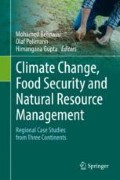Abstract
By 2050, the world’s population may reach 9.1 billion, a 50% increase compared to 2000. To feed this growing population, food and agricultural systems will have to increase their productivity and deal with many challenges such as land and water shortage and degradation problems. In Morocco, agriculture is a key sector of the national economy, playing crucial social and economic roles and generating some negative externalities. Cereals are the dominant crops and their production fluctuates depending on weather conditions. Therefore, cereal yields forecasting is a major tool for decision making to ensure food security, which still relies heavily on cereal production. The present work is essentially oriented towards the study of: water productivity (WP) of rainfed wheat as an indicator of agricultural development related to water management; and winter soft wheat yields forecasting in the rural commune of Ouled Saleh, characterized by a semi-arid climate and limited water resources to satisfy crop growth requirements. The results indicated that WP is relatively low and has to be improved, and that there is a good agreement between predicted and observed soft wheat yields using AquaCrop under rainfed conditions.
Access this chapter
Tax calculation will be finalised at checkout
Purchases are for personal use only
References
Alaoui S.B. (n.d.). Référentiel pour la conduite technique de la culture du blé tendre (Triticum aestivum), 14 p. available at: www.fellah-trade.com/ressources/pdf/ble_tendre.pdf (visited January 23, 2017).
Balaghi R., Jlibene M., Tychon B. & Eerens H. (2013). Agrometeorological cereal yield forecasting in Morocco. INRA, Rabat, 157 p.
Direction Régionale de l’Agriculture de Casablanca (DRA). (Décembre 2010). Monographie agricole de la province de Nouaceur.
El Aydam M., Baruth B. & Balaghi R. (2010). MARS Agrometeorological Vol. 18 No. 7 – Crop Monitoring in Morocco.
Encyclopedia of Soil Science. (2006). Vol. 1. R. Lal. CRC Press, 1923 pages. Pages: 121–126.
Food and Agriculture Organization of the United Nations (FAO). (2009). Software: AquaCrop. (http://www.fao.org/nr/water/index.html)
Haut Commissariat au Plan (HCP), Direction régionale du grand Casablanca. (Juillet 2010). Monographie de la région du Grand Casablanca.
Jacovides, C. P., & Kontoyiannis, H. (1995). Statistical procedures for the evaluation of evapotranspiration computing models. Agricultural Water Management, 27, 365–371.
Jlibene M. (2009). Amélioration génétique du blé tendre au Maroc à l’aube du 21ème siècle. 80 pages, Editions INRA.
Krause, P., Boyle, D.P. & Bäse, F. (2005). Comparison of different efficiency criteria for hydrological model assessment. Advances in Geosciences. pp. 89–97.
Legates, D. R., & McCabe, G. J. (1999). Evaluating the use of ‘goodness-of-fit’ measures in hydrologic and hydroclimatic model evaluation. Water Resources Research, 35, 233–241.
Loague, K., & Green, R. E. (1991). Statistical and graphical methods for evaluating solute transport models: overview and application. Journal of Contaminant Hydrology, 7, 51–73.
Ministère de l’Agriculture et de la Pêche Maritime (MAPM). (2014). Agriculture marocaine en chiffres. Rabat, Maroc.
Moriasi, D. N., Arnold, J. G., Van Liew, M. W., Bingner, R. L., Harmel, R. D., & Veith, T. L. (2007). Model evaluation guidelines for systematic quantification of accuracy in watershed simulations. Transactions of ASABE, 50(3), 885–900.
Mouchrif A., Amraoui F. et Mokssit A. (2015). Caractérisation agro-climatique et liens avec les rendements agricoles : cas du blé tendre dans la région du Grand Casablanca. Afrique Science, Vol.11, n°4. http://www.afriquescience.info/document.php?id=5017
Nash, J. E., & Sutcliffe, J. V. (1970). River flow forecasting through conceptual models, Part I -A discussion of principles. Journal of Hydrology, 10, 282–290.
Office National Interprofessionnel des Céréales et des Légumineuses (ONICL) (2012). Production des céréales, campagne agricole 2011–2012.
Raes D. (2009), “ETo Calculator v3.1,” Land and Water Digital Media Series No. 36, Food and Agriculture Organization of United Nations, Rome.
Raes, D., Steduto, P., Hsiao, T. C., & Fereres, E. (2009). AquaCrop – The FAO crop model to simulate yield response to water: II. Main algorithms and soft ware description. Agronomy Journal, 101, 488–498.
Steduto, P., Hsiao, T. C., Raes, D., & Fereres, E. (2009). AquaCrop – The FAO crop model to simulate yield response to water: I. Concepts and underlying Principles. Agronomy Journal, 101, 438–447.
Willmott, C. J. (1984). On the evaluation of model performance in physical geography. In G. L. Gaile & C. J. Willmottt (Eds.), Spatial statistics and models (pp. 443–460). Boston: D. Reidel.
World Water Forum (WWF). (2012). Contribute to food security by optimal use of water. http://www.worldwaterforum6.org/commissions/thematic/priorities-for-action-and-conditions-for-success/priority-for-action-22/
Author information
Authors and Affiliations
Editor information
Editors and Affiliations
Rights and permissions
Copyright information
© 2019 Springer Nature Switzerland AG
About this chapter
Cite this chapter
Mouchrif, A., Amraoui, F., Mokssit, A. (2019). Ensuring Food Security Through Increasing Water Productivity and Cereal Yields Forecasting – A Case Study of Ouled Saleh Commune, Region Casablanca-Settat, Morocco. In: Behnassi, M., Pollmann, O., Gupta, H. (eds) Climate Change, Food Security and Natural Resource Management . Springer, Cham. https://doi.org/10.1007/978-3-319-97091-2_3
Download citation
DOI: https://doi.org/10.1007/978-3-319-97091-2_3
Published:
Publisher Name: Springer, Cham
Print ISBN: 978-3-319-97090-5
Online ISBN: 978-3-319-97091-2
eBook Packages: Earth and Environmental ScienceEarth and Environmental Science (R0)

